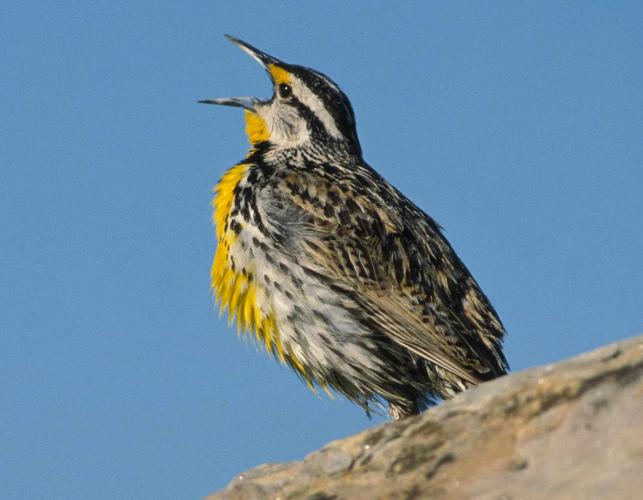The meadowlark is a familiar sight throughout the farmlands of the Midwest.
A bird of open grassland habitats such as hayfields or prairies, meadowlarks often perch prominently on top of fence posts.
A meadowlark has a bold, black V-shaped marking on its yellow breast. The birds are plump and stocky, with long pointy beaks and short tails. Males and females look alike. In flight, meadowlarks resemble quail, alternating quick flapping with sailing on set wings.
Meadowlarks are indeed found in meadows, but they are not larks. The meadowlark actually belongs to the blackbird family.
In meadowlark habitats, the meadowlark’s whistle seems ever present–as much a part of grasslands as the grass. Meadowlarks sometimes sing even in winter, though they are most vocal during the warmer months of the nesting season. There are two kinds of meadowlarks: eastern and western (but you wouldn’t know it by looking at them). The two species are most easily separated by their different songs.
Meadowlarks nest on the ground in thick grassy areas. They weave fine grasses into a nest with a domed roof and side entrance. Meadowlarks consume lots of insects such as grasshoppers. In winter, meadowlarks form small flocks and eat seeds and grain.
Meadowlark Mania
- The majority of the meadowlark’s diet consists of insects. Especially in summer, it eats many grasshoppers, crickets, beetles and their larvae, caterpillars, ants, true bugs, and others; also spiders. Seeds and waste grain make up over one-fourth of annual diet, and are eaten especially in fall and winter.
- Male meadowlarks defend their nesting territory by singing.
- In courtship, the male meadowlark faces the female, puffs out his chest feathers and points his bill straight up to show off his black “V,” spreads tail widely, and flicks his wings; he may even jump in the air in this posture.
- Nests are built by the female meadowlark. They are usually a domed structure with the entrance on the side, made of grass stems interwoven with surrounding growth.
For more on meadowlarks, check out the Audubon Field Guide.
Setting out to go bird watching this spring? Find out how to ID the area’s birds with this helpful guide from the MDC.




Recent Posts
























